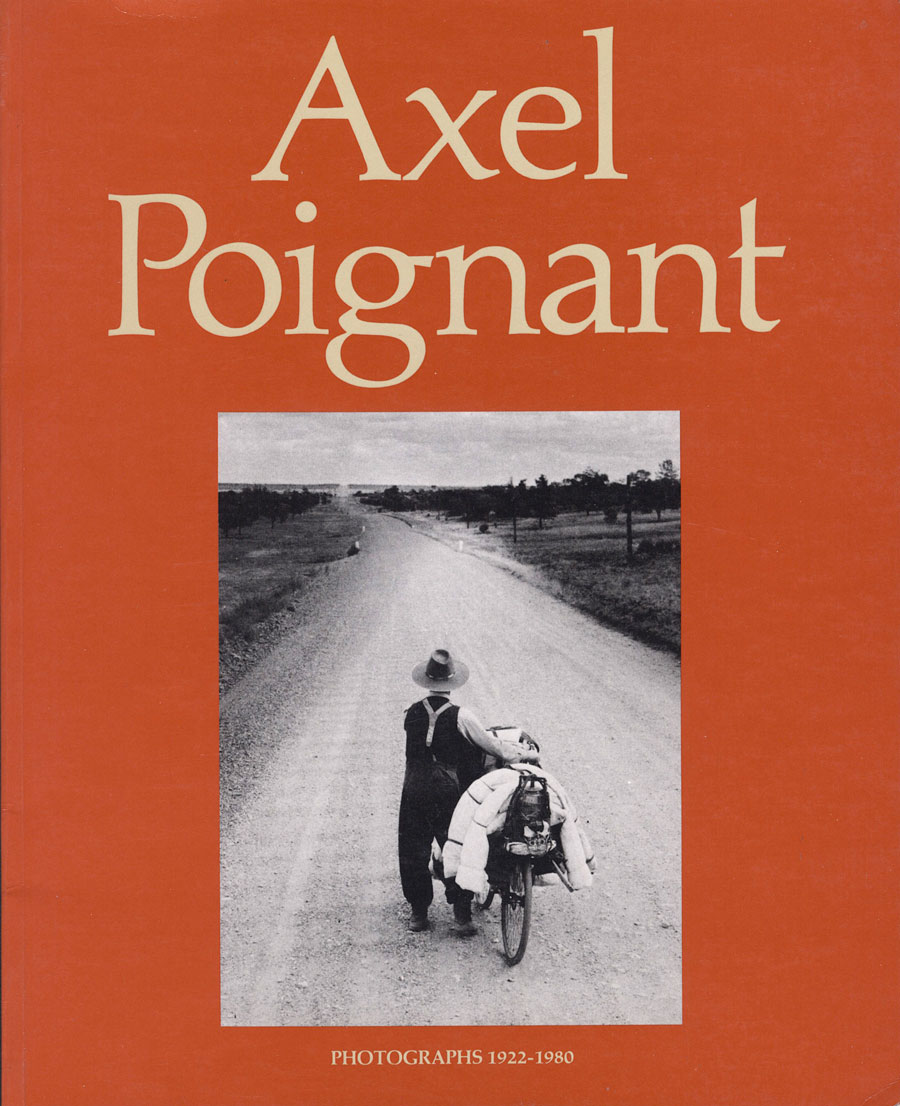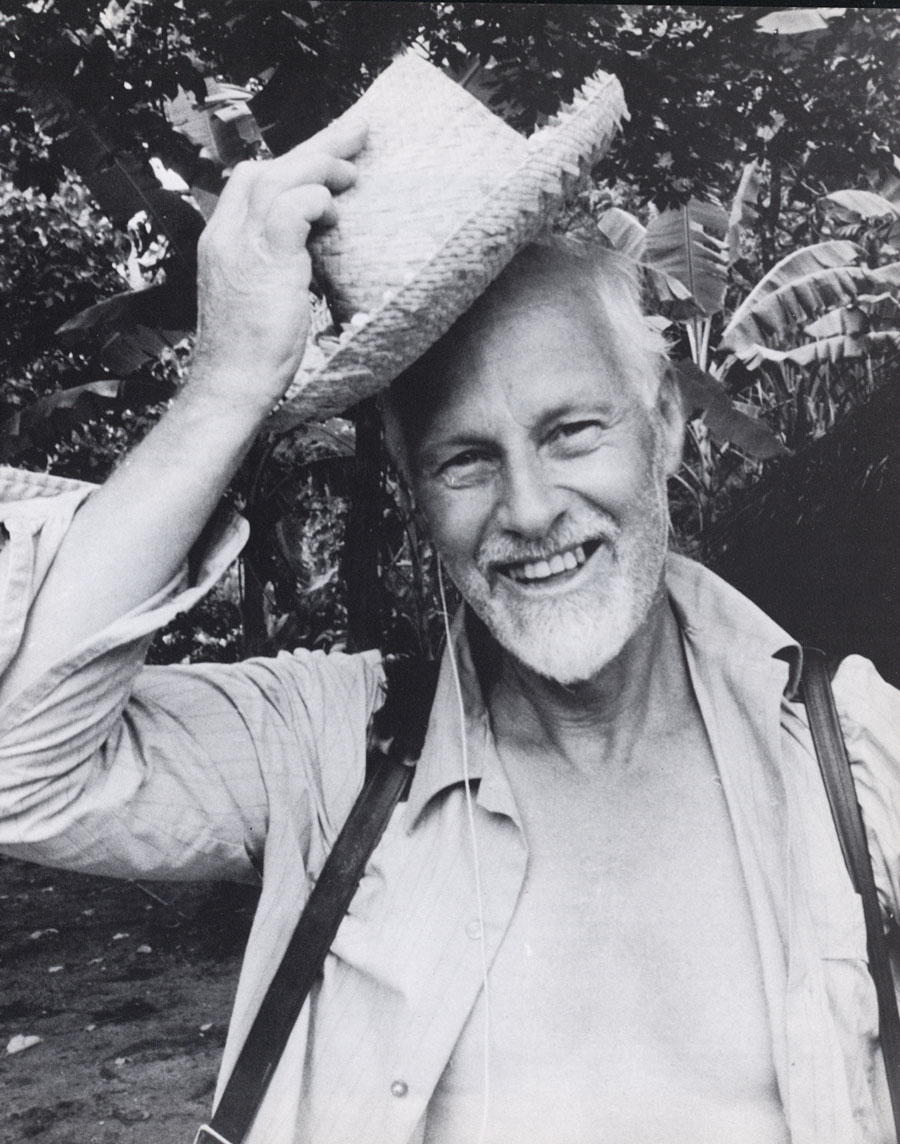
An online version of the catalogue
for the retrospective exhibition of the work of Axel Poignant
1922–1980
The Art Gallery of New South Wales, Sydney 1982 , curated by Gael Newton
Cover: Swagman on the road to Wilcannia, 1953/4 (cat 74)
catalogue essay / biographical details / exhibition prints & checklist /// for more on Axel Poignant
Only Through Images
"I know that my true function within a society which embraces all of us, is to continue an age-old tradition,
fundamental to our civilisation, which goes back into pre-history and will go forward into the unknown future.
This tradition is to create images from the depths of the imagination
and to give them form whether visual, intellectual or musical.
For it is only through images that the inner world communicates at all."
Quote chosen by Axel Poignant from: Sir Michael Tippett, 'One Pair of Eyes',
television lecture series Poets in a Barren Age, BBC, 1972. Reprinted in Moving into
Aquarius, London, Routledge, Regan Paul, 1974
Introductions
ACKNOWLEDGEMENTS
Edmund Capon, AGNSW Director, April 1980
This exhibition examines the long career of the Anglo-Swedish photographer Axel Poignant (b 1906) who adopted Australia as his spiritual home and base for thirty years, from 1926 until his return to London in 1956.
Poignant's contribution to Australian photography is well known, particularly in the fields of photo-journalism and children's book illustration. The frequent re-printings of his classic picture story on two Aboriginal children; Piccanniny Walkabout (now titled Bush Walkabout), attest to its enduring appeal over the years since first publication in 1957.
Owing to his absence from Australia over the past two decades Poignant's work is perhaps less well known in this country than that of many of his contemporaries. It has been the policy of the photography department of this Gallery, since its inception in 1975, to progressively present both surveys and individual retrospectives dealing with the history of Australian photography. It is hoped that this presentation of the work of Axel Poignant will re-acquaint the public with a significant part of our photographic heritage.
It is no easy task to summarize a career spanning nearly sixty years but there can surely be no better way of achieving such a summary than through a retrospective exhibition. This could not have been possible without the continuing help and co-operation of Axel Poignant and his wife, Roslyn. To them we owe special thanks for, whatever else may change, Sydney remains at a considerable distance from London and thus much of the preparatory work for the exhibition devolved upon the Poignants. The curator of photography, Gael Newton, has been responsible for the overall organization of the exhibition and to her too we extend our thanks.
Finally, thanks are due to Hal Missingham, who was director of the Art Gallery of New South Wales from 1945-71, for writing the foreword. Amongst his many achievements Hal Missingham is a well-known photographer in his own right and it is no doubt pleasing to him that the work of an old friend should be the subject of a major exhibition in the new photography gallery.
FOREWORD
Hal Missingham Perth 1981
This retrospective exhibition of one hundred and thirteen works by Axel Poignant covers a period of nearly sixty years and clearly reveals the photographers' deep and wide-ranging interests. He has the visual awareness of the true artist and the photographer's ability to isolate the one important moment in a continuing sequence of events.
I was introduced to Axel by a mutual friend, the architect Harold Krantz, when I arrived home in Perth from London in mid-nineteen forty. We became immediate friends. Axel was one of the few professional photographers in Australia using the miniature 35 mm Leica camera, invented by Dr. Oskar Barnack in 1925, which was to completely revolutionise photographers' thinking and approach to photography. I had bought my first Leica in London in 1932, being interested, as a painter and graphic artist, in the astonishing sharpness of the images which could be produced.
Any significant artist will choose and develop the methods and techniques he feels will best express the message he wishes to convey; drawing, painting, sculpture, or one of the graphic mediums. Axel chose the camera. In these photographs we see how brilliantly he uses it to illuminate the myriad facets of life, in a multiplicity of images of ourselves and our surroundings.
Axel had a photographic studio in London Court in the central business area of Perth, Western Australia.
A considerable part of his income came from producing not only society portraits, but from compiling attractive small sequence-albums of photographs of people's children at play — ideal subjects for the candid camera technique. But his heart and his interests lay elsewhere, particularly in nature, as the early reportage sequence of the felling and logging in the great Karri forests of the south-west, (7-14), and the remarkable close-up of the sea-osprey, (25) indicate so clearly.
On first seeing these prints I was sure that they should be publicly exhibited, and Axel agreed, somewhat diffidently, to my suggestion that we hold a joint exhibition. It was opened on September 16th, 1941, at Newspaper House, Perth. We made fifty prints each, enlargements from the miniature negatives to 38 x 35 cm and larger.
They caused quite a stir, not only because of the unusual choice of subject matter, from extreme close-ups to aerial shots, but because of the sharpness and clarity of the enlargements, almost unbelievable to most professional photographers, used to large format cameras with half-plate or whole-plate negatives. Numbers 14,16,17, 18,19, 21,22, 23, 24, 25, in the present exhibition were included in the 1941 exhibition.
During the two weeks of the exhibition we gave six lectures in the form of discussions between us, including The artist's eye and the camera eye, The miniature camera and its uses, Selection of subject matter, and Using your camera creatively.
All heady stuff!
Creative artists are able to — and must at times — shut themselves off completely from distracting surroundings and happenings when working on a particular problem. Axel has this ability to a marked degree! On a weekend expedition to the Moore River north from Perth, Axel and Vincent Serventy were keen to take photographs of a porcupine fish known to be on the sea beach.
It was a difficult journey over rough country, during which we lost the car battery, broke off one of the doors, and holed the sump. Jamie Linton and I worked the entire weekend extemporising repairs, while Axel single-mindedly concentrated on this photography.
He always has his priorities right!
Whether he was working with friends, in the army, or with Harry Watt filming The Overlanders, he would lose interest in what he was doing if a rare bird or animal, or any other beguiling object claimed his intense interest and his camera.
A fine artist is always a fine craftsman. Axel spends endless hours perfecting his techniques. He prints and re-prints his photographs until he is quite satisfied that he has obtained the best possible result from his negatives. |
|

Axel Poignant by Roslyn Poignant, Raiatea 1969 (uncatalogued) |
The end results are outstanding as you see when studying and enjoying Aboriginal girl with new born baby (29), The Songman (67), and the sequence of Aborigines with whom Axel had such an affinity and who welcomed him as one of their own. Axel Poignant has that rare and rewarding trait — he likes humans and they immediately like him, feeling no shyness or embarrassment in his presence.
In selecting works for an exhibition the artist naturally chooses those that he feels best portray his ability, but, over and above this, also expresses his whole attitude to life. These photographs certainly do this. They also not only cover a time-span of some sixty years, but, as well, record the results of Axel's innumerable peregrinations in Australia and elsewhere.
Use the menu below to open other sections
catalogue essay / biographical details / exhibition prints & checklist
for more on Axel Poignant
Exhibition Dates
The Art Gallery of New South Wales, Sydney 17th July - 29th August, 1982
The Art Gallery of Western Australia, Perth 20th September - 24th October, 1982
The National Library of Australia, Canberra 13th December, 1982 - 30th January, 1983
Exhibition organiser:
Gael Newton, AGNSW Curator of Photography
more of Gael Newton's Essays and Articles
|

